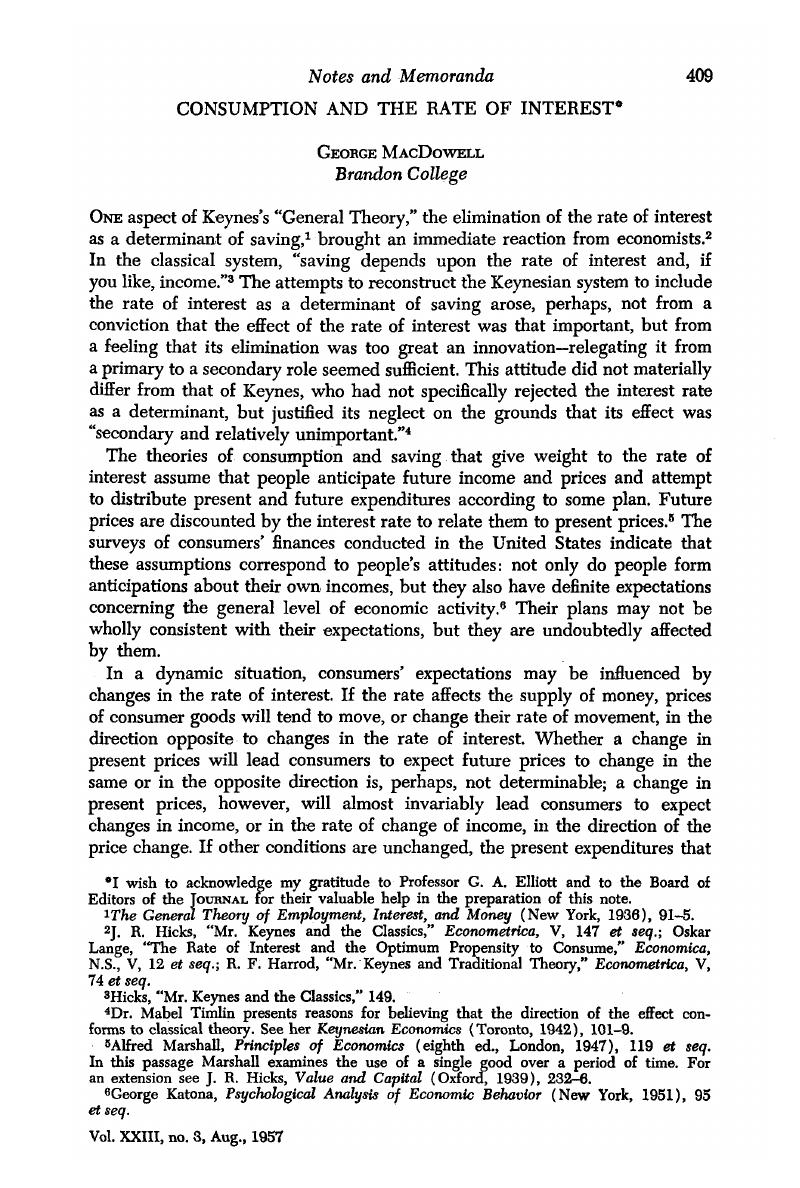Published online by Cambridge University Press: 07 November 2014

I wish to acknowledge my gratitude to Professor G. A. Elliott and to the Board of Editors of the Journal for their valuable help in the preparation of this note.
1 The General Theory of Employment, Interest, and Money (New York, 1936), 91–5.Google Scholar
2 Hicks, J. R., “Mr. Keynes and the Classics,” Econometrica, V, 147 et seq. Google Scholar; Lange, Oskar, “The Rate of Interest and the Optimum Propensity to Consume,” Economica, N.S., V, 12 et seq. Google Scholar; Harrod, R. F., “Mr. Keynes and Traditional Theory,” Econometrica, V, 74 et seq.Google Scholar
3 Hicks, , “Mr. Keynes and the Classics,” 149.Google Scholar
4 Dr. Mabel Timlin presents reasons for believing that the direction of the effect conforms to classical theory. See her Keynesian Economics (Toronto, 1942), 101–9.Google Scholar
5 Marshall, Alfred, Principles of Economics (eighth ed., London, 1947), 119 et seq. Google Scholar In this passage Marshall examines the use of a single good over a period of time. For an extension see Hicks, J. R., Value and Capital (Oxford, 1939), 232–6.Google Scholar
6 Katona, George, Psychological Analysis of Economic Behavior (New York, 1951), 95 et seq. Google Scholar
7 Dauer, E. A., Comparative Operating Experience of Consumer Instalment Agencies and Commercial Banks (New York, 1944), chap. 11.Google Scholar
8 Federal Reserve Bulletin, 02, 1955, 184.Google Scholar
9 MacIntosh, R. M., “The Bank Act Revision of 1954,” Canadian Banker, winter, 1955, 92.Google Scholar The point discussed indicates a possible future trend.
10 The saving curves would diverge if consumption were affected by the interest rate in the same proportion, say 1 per cent for each change of 1 per cent in the rate of interest, at all levels of income.
11 Katona, George, “Variability of Consumer Behavior and the Survey Method” in Klein, L. R., ed., Contributions of Survey Methods to Economics (New York, 1954), 49 et seq. Google Scholar
12 Morgan, J. N., “Factors Related to Consumer Saving When It is Defined as a Net-Worth Concept” in Klein, L. R., ed., Contributions of Survey Methods to Economics (New York, 1954), 89 et seq. Google Scholar
13 Katona, , Psychological Analysis of Economic Behavior, 159.Google Scholar
14 Lydall, Harold, “The Life Cycle in Income, Saving, and Asset Ownership,” Econometrica, XXIII, 131 et seq. Google Scholar
15 Mack, Ruth, “The Direction of Change in Income and the Consumption Function,” Review of Economics and Statistics, XXX, 248.Google Scholar
16 Ibid., Table 4, p. 250.
17 Ibid., 249 n.
18 Ibid., 249.
19 Duesenberry, J. S., Income, Saving, and the Theory of Consumer Behavior (Cambridge, Mass., 1948), 89.Google Scholar
20 Brown, T. M., “Habit Persistence and Lags in Consumer Behavior,” Econometrica, XX, 355 et seq. Google Scholar
21 Ezekiel, Mordecai, “Statistical Investigation of Saving, Investment, and Consumption,” American Economic Review, 03, 1942, 22 et seq. Google Scholar See also Katona, , Psychological Analysis of Economic Behavior, 158.Google Scholar
22 The natural division of a year, and the period of income receipt may, however, affect consumers' actions.